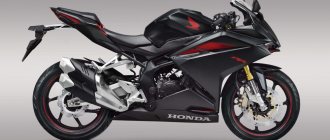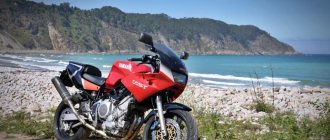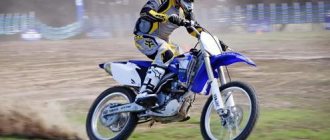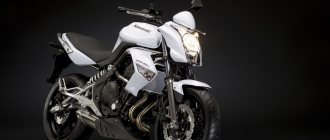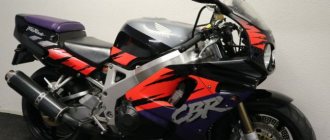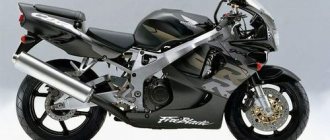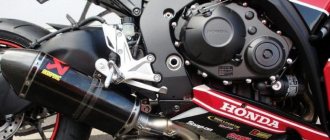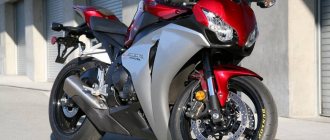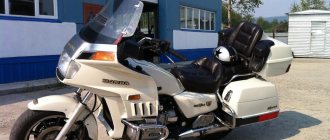Appearance
Honda CBR 900 RR Fireblade looks typical for the series. The frame tightly covers the filling, and the colors are bright and sporty. The body lines are angular, but not too much. But the wheels here, although alloy, are still much more refined than those on most other sports bikes.
Otherwise the car looks quite normal. It is impossible to call a motorcycle the height of elegance. At least the later models. There is an important point to understand: the first car had the most harmonious design, with round headlights at the front. And then the design changed to suit new trends, and the motorcycle became more modern in appearance, but it was not possible to fundamentally change the design. For example, smooth out corners everywhere. That’s why in the end the model turned out to be modern, but in many ways it resembles the past.
Modifications
In an effort to reduce the gap between medium and cubic capacity technology, the developers of the fire blade carried out 4 major restylings. These were the only changes.
Honda CBR900RR Fireblade – 1992-1994
Honda CBR900RR Fireblade – 1995
Honda CBR919RR Fireblade – 1996-1999
Honda CBR929RR Fireblade – 2000-2001
Honda CBR954RR Fireblade – 2002-2003
There were no plans to release new bikes based on the first blades. However, the engine of the fireblade line was used in some other developments of the Honda concern.
Comfort
With a height of 183 cm, it is comfortable to sit on a motorcycle. And no less convenient is that the motorcycle is really reliable. The fact that there were no malfunctions on the sportbike for 30 thousand kilometers speaks volumes. Still, the class itself is not very conducive to reliability (theoretically), because the higher the characteristics and the more complex the device, the usually higher the probability of failure (the general principle applies not only to bikes).
The motorcycle is too fast and sharp for a beginner in the class. However, even if a person is accustomed to motorcycles with such a seating position, but in no way wants to use the capabilities of the engine, this option will not suit him either. It is better to purchase a small-capacity and low-power sports motorcycle, which can be used as a pleasure bike without fear that it will explode if moved carelessly.
text:
Denis Parfenov,
photo:
Fot'n'RacerHonda CBR900RR Fireblade
: 893 cm3, 124 hp, 260 km/h, 1992, $ 5100
Honda CBR900RR Fireblade
: 916 cm3, 128 hp, 265 km/h, 1997, $ 7200
Honda CBR900RR Fireblade
: 929 cm3, 152 hp, 280 km/h, 2000, $ 9200The Fireblade became the epitome of 100% sportbike immediately after its debut. Five modifications – and each time something new. How about tasting the difference? In a comparative test, three generations of the legendary “blade” collided.
Tsunami of popularity
Autumn 1991, Cologne Motor Show, presentation of a new sportbike from Honda. Everything connected with this presentation can be described in one word - furore. Even now, the performance of that first version evokes admiration, but then... The motorcycle crowd froze in admiration at the stand. Still would! The first “blade” operated with the power of an 1100 cc sportbike and the dimensions of a “six hundred”. Steering geometry of a 250 cc Grand Prix car. In addition, record power-weight indicators. A super-handling motorcycle, a fast engine, good brakes... Only Yamaha responded adequately, and even then six years later, in 1998. Agree, being a leader in the most prestigious class for six years is the best confirmation of the highest level of the company’s design school. The Yamaha YZF-R1, which replaced the Fireblade, remained on the throne for only three years, losing it two years ago to the liter “jikser”...
The evolution of the Fireblade briefly looks like this: in 1992 the first “razor” appeared, a couple of years later it received minor changes in plastic (fox-eye headlights) and the speedometer drive from the output shaft of the gearbox. In 1996, the engine was bored out to 919 cm3. The first “fires” lasted six years without any major changes. Of course, if you are already a king, then you can live in peace. But when you were overthrown... Since 1998, when Yamaha declared its rights in the “liter” class, major changes to the design of the Honda motorcycle were made every two years, and each time this was done in the hope of regaining the title. First, more powerful brakes and a concave radiator for the cooling system were installed. Then - two years later - modernization again. This time a completely different model was released with a 929 cm3 engine, a new frame and suspension. In 2002, the engine capacity was increased to 954 cc, the frame and plastics were changed again... Alas, the CBR9929 did not have the same characteristics as the Yamaha YZF-R1, and the CBR954 did not match the other favorite - the liter "Jixer". A full-fledged “liter” appeared only four months ago (“Motoreview” N 11-12/2003) and what its place in the modern table of ranks is not yet clear. One thing is clear: it will not be easy for him to win the title of “king”. As, indeed, is the fact that “people” still have, first and foremost, memories of the old versions of Fireblade. They are still valued by our motorcyclists to this day. Let’s return to these models for a detailed look...
Old age is a joy
The 1992 motorcycle turned out to be in unusually good condition. The low mileage on his odometer is very close to the truth. Among the shortcomings are only small plays in the rear suspension links - perhaps from hard landings after a “stop”. The motor runs smoothly and quietly. The “diesel” sound of the engine, characteristic of “razors” produced in 1992-1997, is almost inaudible at medium speeds. Temperature is normal, 5000 rpm, release the clutch, let's go! Acceleration is intense even by modern standards, even though the motorcycle is 11 years old! The box works smoothly, but sometimes it is possible for the gear to “under-engage” when shifting up. The first five gears reach the red zone, we switch to sixth, lie down like scouts under fire and... wait. 250 and 260 km/h are reached quite quickly. But then the struggle between the “hardware” and the air begins for each speedometer mark. At 270 km/h the hardware gives up. Not a lot by modern standards. The same Suzuki GSX-R750Y “runs” 275 km/h. And the liter GSX-R actually had to put a speed limiter at 299 km/h, so as not to further irritate legislators (there are only three motorcycles with such limiters, the rest physically cannot go more than 300). Well, to hell with it, with the maximum speed. You still don’t check it more than once a month. The main thing is that at operating speeds there is both traction and controllability. And there are brakes! Fireblades have always been best in class in this regard. Both the R1 with four-piston Sumitomo and the Jixer with six-piston Tokico lacked the power, confidence and feedback of the razor brakes of similar years. And for the 2004 season, newfangled radial front brake calipers appeared. I have no doubt that the “razor” will once again “outslow” its competitors...
I really liked the landing. When you sit on a motorcycle, you can't see the tank at all. He is completely under you. The instrument panel is visible along the lower edge of the helmet visor (the speedometer is clearly readable only from 160 to 260 km/h, when the arrow points up). Half of the area of the rear-view mirrors is occupied by stripes on the sleeves of the jacket, the other half is a picture of the road behind the motorcycle, which is acceptable. The device is very compact. The clip-ons are low and the fit is sporty. If you want to go on the “ring”, then it would be nice to have the footpegs a little higher so that you can merge with the vehicle into one tense whole. And if you also take into account that the engine and chassis are incredibly reliable, then it becomes clear why not only athletes, but also tourists love the “razor”. And there are mounts for the central case on all Fire models up to 2003. But, for example, for the 2002 R1 or the liter “Jixer” they do not exist!
Back in 1992, many magazines wrote phrases like “our testers were afraid to ride this monster” in their motorcycle tests. Now, of course, it looks comical. An ordinary, even quiet by the standards of 2003, device, with adequate controllability, average power-to-weight ratio and good brakes. I wouldn’t recommend it as the first motorcycle in life, but you can switch to one from a “400” without straining. The main thing is not to turn off your head while driving.
Less sport, more life!
If the second participant in the test were the 1998 model, it would undoubtedly look more correct from a technical point of view - there are many more changes compared to the first generation. But the external difference with the next generation motorcycle is so great that we replaced the 1992 device with a 1997 device - the second generation. We go, we try to find the difference and we don’t find it! Except that the younger model has a headlight of a different shape, and the clip-ons are a centimeter higher. A high steering wheel is more comfortable on long journeys and in the city. In general, all the modifications to the “razor” from 1992 to 1999 made it less and less a sportbike and more and more a motorcycle for life. To make it more convenient for the pilot, more reliable, safer, simpler. The height of the windshield and steering wheel grew, the nervousness of the engine was smoothed out, and the weight of the motorcycle increased. Drop by drop, as you know, the stone is sharpened... Did Fireblade fans like it?
If you choose between the 1992 and 1997 models, you need to rely only on the condition of the motorcycle and the requested price. I like the very first device better – white with a purple seat. If competitors of similar years of production have already fallen into the “junk” group, then this one has half moved from it to the “classic racers” team, because 11 years, by sportbike standards, is no longer just old age. This is already the age for stories like “when my grandfather’s grandfather had not yet gone to the neighboring village to visit women, this motorcycle was already tearing everyone apart at the “ring” ...”. It doesn’t have the aura like the 1986 GSX-R750 yet, but the holes for its mounting have already been drilled.
In general, an interesting observation: among the “blades” of 1992-1999, the easiest to sell are motorcycles of the very first generation (1992-1993) and the most recent (1998-1999) model year. Those who really have little money will buy the cheapest motorcycle. Those who have enough money for a 1996 model will also save up and buy a 1998 car. This is probably why the price range for motorcycles from 1992-1997 is so small. And the bottom line of this spread stopped at a rather impressive figure for an 11-year-old motorcycle: $5,000, which once again proves that the model was ahead of its time and is still desired and appreciated by connoisseurs.
Motorcycles from 1992-1997 have two headlights with H4 bulbs. But in low beam only the left one works. This was done so that in the rearview mirror, with both headlights on, the motorist would not mistake you for a car driving far behind. There is logic in this (it’s not clear how Kawasaki and Yamaha got around this limitation?), but still the most common tuning for the “razor” is to run the missing third wire from the left headlight to the right, so that both work on low and high beam "eyes". The generator and battery tolerate this upgrade normally. The non-standard size of the front tires (130/70-R16) on the “blades” of these years of production imposes some restrictions on the choice of “shoes” for the front wheel. Many of the newer designs are not produced in this size, especially in the supersport class for the track. Of the available models, Bridgestone VT010 and Pirelli Diablo have proven themselves to be very worthy; Michelin Pilot sport will also be a good choice. A 180/55-R17 cylinder, which is completely standard for modern motorcycles, is placed at the rear, and here your imagination is not limited by anything. You can even install a “skating rink” 190 mm wide, but this will not lead to anything positive - the motorcycle will become less willing to turn and will acquire the habits of a boring “tourer”. Bet on red
If the first two motorcycles in the test are brothers, then the third is clearly an adopted one. With good genes, but from a completely different family. This is simply a different device that has nothing in common either in design or mechanics with the old “blades”. Swift, light, powerful, modern. It doesn’t even have Fireblade written on it (the red copy came to Russia from America, and these guys generally like to change names for their market).
A very clear gearbox (not a single error when shifting during the whole day of driving), excellent handling, full storehouses of power and torque in the engine, comfortable seating and excellent suspension. To be honest, there’s not even anything to scold. All liked it. I didn’t just like it, I fell in love with it. This is a fairytale. Or a song. Or both at the same time. This is how a sportbike should be. Yes, it is weaker than the “Jixer” and R1, but you clearly control all of its numerous “mares”, and you use them all without reserve. And there is also the nuance of operation... Not a single "erka" can withstand two seasons of our ring without rebuilding the engine, but this "razor" can. It will also be sold after this, and will please the new owner for a long time. But let's go into detail and in order.
I have only one complaint about the motorcycle: I spent a long time trying to find the cylinder for the key that opens the seat tank. I couldn’t find it in the logical places on the side, behind and above the “tail.” Having stopped rejecting stupid hypotheses only on the basis of their stupidity, I looked under the “tail”. And I found it. How this will all work, and how pleasant it will be to shove an expensive ignition key with an immobilizer there after 1000 km in the rain on Russian roads, I don’t even want to imagine.
The motorcycle differs from the first Fireblade in the shape of the tank - in profile it is classic semicircular, as on all modern Honda motorcycles, and more elongated when viewed from above. In general, the motorcycle seems narrower, longer and leaner. Like a hound dog - all muscles and swiftness. The windshield throws oncoming air flows into the shoulders, and does this job perfectly. But, like any production sportbike, a taller glass wouldn't hurt. In order not to spoil the image of a racing motorcycle, choose the Racing version (also called Double Bubble). The instrument panel is easy to read, the antifreeze temperature indicator and speedometer are digital, there is a clock and two trip meters. The headlight is now three-lamp. In the low beam, the rectangular center of the headlight works; when the high beam is turned on, it is joined by round beams of light on the sides. Looks ominous and is a good suggestion to give way. If you want to add some “show-off”, put xenon on the low beam - with single-filament lamps with an H7 base it is much simpler, cheaper and more reliable than with double-filament lamps.
The motorcycle is much more flexible when riding slowly than the first razors. And all because instead of carburetors there is electronic fuel injection. In the factory settings, the torque and power graphs are very smooth. The device allows you to move off smoothly without using the throttle, and to drive calmly without turning the engine above 5000 rpm. There is no nervousness or protest. An ordinary flexible city motorcycle for every day.
If you unscrew the gas in first and second gears, the headlight, like an air defense searchlight, begins to look for helicopters in the sky and illuminate signs above the road. When landing, the front wheel wobbles noticeably. If you found 9-10 “kilobucks” for this motorcycle, do not regret another $300-500 for a good steering damper. No matter how Honda convinces us of its uselessness, it is difficult to agree with this statement. If you want to remain faithful to Honda, choose the Showa brand, your conscience will remain clear...
If you unscrew the knob in higher gears, very smooth and assertive acceleration occurs. Perhaps lovers of sharp “pick-ups” will say that the engine is “bland and uninspiring,” but the future lies with such engines – powerful and smooth. The explosive nature of two-strokes is buried with the two-strokes. This is clear. Amen! A new generation of motorcyclists has grown up who do not know and do not want to know what a reed valve is, a separate lubrication system, and how maximum torque and maximum power can be together at 11,000 rpm.
I really liked the brakes. Giant discs, four-piston “golden” Nissin calipers and sensitive brakes from the same company. Even with standard rubber hoses, the deceleration is measured very precisely, and the motorcycle bites the front wheel into the asphalt. If you want to lift the rear wheel off the ground, just press the lever a little harder. There is no need to catch the resonant swing by releasing and pressing with all your might. When replacing hoses with reinforced ones, braking forces will not be added, sensitivity will improve, and you can move on to working on the “rolling stop” element.
Budget is everything
It’s hard to give advice on choosing a motorcycle in general and a sportbike in particular. Whatever one may say, any opinion is personal, and it is incorrect to impose it on others. But when choosing a FireBlade, everything is simpler: one must proceed not from the opinions of experts, but rather from financial capabilities.
If they are not limited, order the 2004 model. New optics design, under-seat muffler, real liter engine, fragments of the DNA of the victorious RC211V. The device promises to be very angry and sporty. If the bar is $10,000-12,000, look for the CBR954RR - it is more powerful, sportier and lighter than the 929. Moreover, it looks more modern and aggressive. Although, I was carried away from our topic... Emotions, you know, they go ahead of us...
Not enough for 954? Buy a FireBlade 929. There is a huge difference between the 929 (2000-2001) and the 919 (1998-1999), and this difference is really worth the money asked. Put off buying a motorcycle for a little while, or borrow “green money” from friends. You won't be disappointed.
Really not enough for the 929 - buy the 1998-99 model - this motorcycle is much loved by stuntriders for its indestructibility, power and brakes, and is respected by motorcycle tourists for the same indestructibility, convenience and speed.
And if you only have $4000-6000, then any of the 1992-1997 models that turn up in good condition and for reasonable money. There is really very little difference between them - they are all time-tested, hardy “stallions”. Maybe not the fastest racing horses, but proven in battle and not afraid of shots and explosions. This “horse” will not let you down.
So choose according to your level of capabilities and don’t hesitate. The only thing better than a “blade” is a “blade”...
Previous photo Next photo Honda CBR900RR Fireblade parameters: 893 cm3, 124 hp, 260 km/h, 1992, $5100
Model Honda CBR900RR Fireblade Debut/start of production, 1991/1992 1991/1997 1991/2000 Dry weight, kg 185 183 170 Curb weight, kg 206 203 200 Dimensions, mm 2030x685x1115 2030x685x1115 2040x720x1140 Base, mm 1405 1405 1400 Seat height, mm 790 810 815 Ground clearance, mm 145 130 140 Front fork angle 23,75 Engine 893 cm3, 4-stroke, 4-cylinder, DOHC, 4 valves, liquid cooling 918.5 cc, 4-stroke, 4-cylinder, DOHC, 4 valves, liquid cooled 929 cm3, 4-stroke, 4-cylinder, DOHC, 4 valves, liquid cooling Dimension, mm 70x58 71x58 74x54 Supply system 4 CV Keihin carburetors? 38mm 4 CV Keihin carburetors? 38 mm fuel injection Power, hp/rpm 124/10500 128/10500 152/11000 Torque Nm/rpm 90/9500 91/8750 103/9000 Transmission 6-speed gearbox, multi-plate wet clutch, chain Frame diagonal, aluminum alloy Front suspension telescopic fork, Ø43 mm, travel 120 mm telescopic fork, Ø43 mm, travel 120 mm inverted telescopic fork, Ø43 mm, travel 120 mm Rear suspension pendulum, monoshock absorber, stroke 135 mm Front brake 2 discs Ø296 mm, 4-piston caliper 2 discs Ø296 mm, 4-piston caliper 2 discs Ø330 mm, 4-piston caliper Rear brake 1 disc Ø220 mm, 1-piston floating caliper Front wheel 130/70-16 130/70-16 120/70-17 Rear wheel 180/55-17 180/55-17 190/50-17 Gas tank volume, l 18 Maximum speed, km/h 260 265 280 Fuel consumption, l/100 km 6,8 6,9 6,5
Dimensions and weight
The tank is spacious, and even significant fuel consumption does not offset this. The curb weight is decent, which means that such a car may not be very comfortable for people with a light build. And, perhaps, if you lack strength or body size, it is better to choose something lighter.
Dimensions:
- tank – 18 l;
- ground clearance - 130 mm;
- curb weight – 206 kg;
- height – 1130 mm;
- width – 675 mm;
- length – 2055 mm;
- seat height – 800 mm.
The height of the saddle is average, as is the width. The ground clearance here is low and, combined with insignificant suspension travel, makes the bike not suitable for bad roads. However, this car is suitable for an ordinary country road.
002_MOTO_0710_038
“European” from “American” can be distinguished not only by the inscriptions, but also by the presence of the HISS immobilizer system on “Europeans” and “domestic Japanese” (HISS light on the dashboard and a characteristic blotch with the same sticker on the ignition switch - key code transceiver) and regarding the operation of lighting technology: on “Americans” the headlight is on all the time while the engine is running, and the front turn signals serve as the dimensions.
The version for California was equipped with a catalyst and a lambda probe (by the way, very reliable), you can distinguish it by the characteristic catalyst cylinder in front of the muffler. “European” from “American” can be distinguished not only by the inscriptions, but also by the presence of the HISS immobilizer system on “Europeans” and “domestic Japanese” (HISS light on the dashboard and a characteristic blotch with the same sticker on the ignition switch - key code transceiver) and regarding the operation of lighting technology: on “Americans” the headlight is on all the time while the engine is running, and the front turn signals serve as the dimensions. The version for California was equipped with a catalyst and a lambda probe (by the way, very reliable), you can distinguish it by the characteristic catalyst cylinder in front of the muffler.
Only after this can you proceed with a routine examination. We compare the odometer readings with the cutness of the brake discs, the wear of the steering wheel handles, footrests and the number of scratches on the wheel rims from the tire changer. Listen to the engine for noise. If a slight rustle is acceptable on the right side of the engine (can be treated by replacing the timing chain and tensioner) and a clattering sound (can be eliminated by adjusting the valve clearances), then rhythmic knocks and metallic clanging are unacceptable. This engine (with the factory designation SC44) is generally difficult to kill if it contains oil and antifreeze, it can easily handle five-digit mileage figures, but, as they say, you can foolishly break the steering wheel. Up to 50 thousand mileage, rarely any noise comes out, after that the listed sounds are quite acceptable. Next, we wait until the engine warms up and drops speed from warm-up 1600–1800 to idle 1000–1100. We depress the clutch for ten seconds, wait until the gearbox gears stop, and listen. Then we let go and analyze the nature of the noise: if it’s just a metallic hum, it’s good, if it’s crackling, it’s bad: the gearbox probably knew shifting without a clutch at full throttle.
Specifications
In terms of its parameters, this is a fairly modern bike. There are two brake discs at the front, not one. Acceleration to 100 impresses even those who are accustomed to the sports class. The top speed doesn't disappoint either.
| Rear brakes | one disc, 220 mm |
| Front brakes | two discs, 296 mm |
| Rear suspension | pendulum, 125 mm |
| Front suspension | telescopic fork, 110 mm |
| Overclocking | in 3.13 s to 100 km/h |
| Speed limit | 254 km/h |
| Torque at the limit | 89 Nm |
| Power to the limit | 124 hp |
| Steps in a box | six |
| Drive type | chain |
| Fuel consumption | 5.88 l per 100 km |
Unlike a motocross motorcycle, this machine is not at all suitable for use in rough terrain. Even road motorcycles are better suited for these purposes. Within the sports class, the technical characteristics of the model look decent, meeting the requirements of modern times.
Flaws
Adrenaline connoisseurs should take into account that if you ride aggressively, the tires on this bike will be a waste.
- High center of gravity . With excellent maneuverability, it will be difficult to enter a sharp turn at speed.
- High fuel consumption in the urban cycle (according to user reviews, up to 8 liters ).
- Noisy exhaust . Even at idle speed there will be a “diesel” sound.
- No steering damper .
A good steering damper can be a lifesaver at high speeds. - Inconvenient brake light angle . The driver behind the trailing truck simply couldn’t see him from her height.
and dignity
- Nice, large glove compartment under the seat . There are stock hooks on the plastic for using the net (to fasten the helmet).
- Good gear ratios. In urban conditions, you can drive in 1st gear (range from 0 to 120 km ).
- Indestructible checkpoint.
- Weight distribution . Despite the powerful engine, the bike is easy to drive. The axle load ratio of 48/52% is comparable only to a bicycle.
- Excellent brakes . It stops instantly, but you have to get used to it if the user is not ready to fly over the steering wheel at every traffic light.
What do the owners say?
Owners have different opinions. Some people think that the bike is too sharp, while others, on the contrary, emphasize this as an advantage. One thing is clear: the car starts sharply, and it is important to move away carefully. And don’t think that this only applies to beginners. An experienced biker with excessive self-confidence sometimes finds himself in a dangerous situation.
The engine, judging by the reviews in various videos, is praised by almost everyone. And no one complains about reliability. As for standing on the rear wheel at first and second speeds, many are skeptical about the descriptions of those who have done this. And there are reasons for this. Putting a bike like this on the rear wheel at such low speeds is an art, if not impossible.
IMPORTANT! A person 183 cm tall will be comfortable on a bike. But if you are very tall, then when a person lies on the tank, he will be too close to the windshield, and there may not be enough space for his feet.
As for the dashboard and comfort in general, there are no complaints. One review noted, however, that the devices could be more intuitive. But such assessments are few, and if you look at the photo of the dashboard, it is obvious that it complies with all the principles of placement of indicators.
The CBR 900 RR Fireblade is an excellent model that is suitable for experienced sport bikers. And only for them. Firstly, considering how much the car costs, it is not affordable for everyone (taking into account the costs of maintenance and spare parts). Secondly, this sportbike is too powerful for an inexperienced rider.
Who is it suitable for?
The motorcycle is optimally suited for drivers of average height.
The bike was originally planned as an export version.
According to user reviews, a motorcyclist must be at least 170 mm tall for a comfortable ride.
Although the appearance (especially of the latest editions) of the fire blade suggests a low stance, the footrests were raised in the process, which can create inconvenience for people of short stature.
